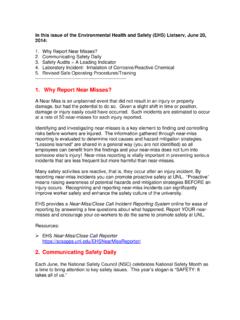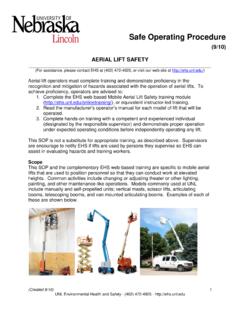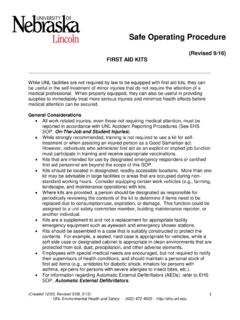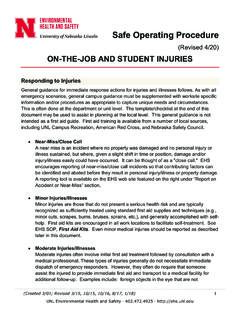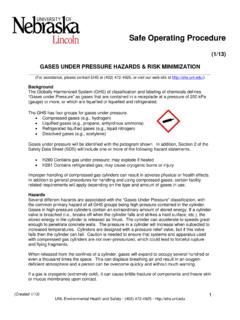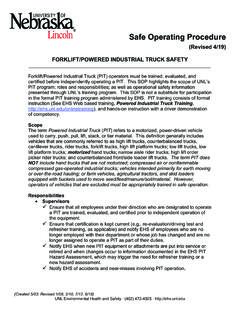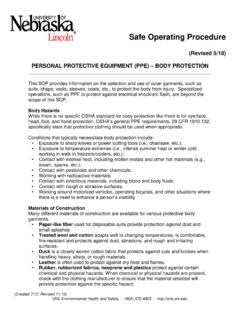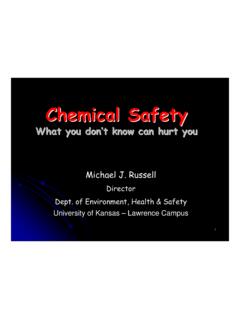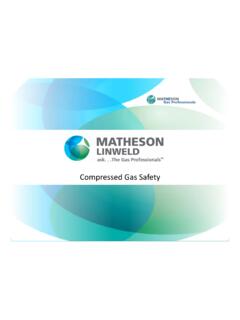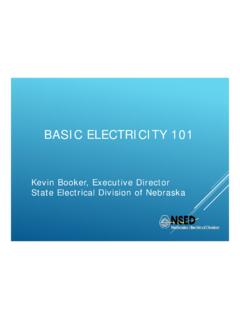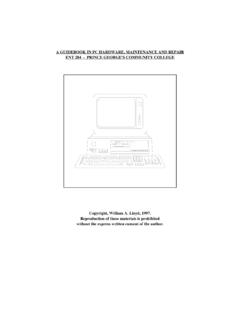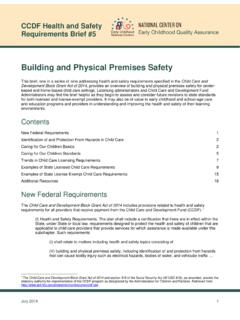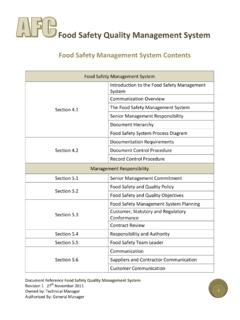Transcription of (Revised 8/15) GENERAL MACHINE SAFETY
1 (Created 10/12) UNL Environmental Health and SAFETY (402) 472-4925 Safe Operating Procedure (Revised 8/15) GENERAL MACHINE SAFETY _____ This SOP is intended to provide GENERAL SAFETY guidance for power-driven (including manually operated) stationary machines and equipment used to shape and/or form metal, wood, or other materials by cutting, impact, pressure, electrical or other processing techniques. These types of machines present a number of potential hazards, which must be recognized and controlled to minimize the risk of operator injury.
2 Hand and portable powered tools are beyond the scope of this SOP. Relevant Standards Following are common, recognized standards for safe MACHINE operation. The content of this SOP is drawn from these standards. MACHINE operators are encouraged to become familiar with the content of the cited standards relevant to their work. 29 CFR 1910, Subparts O, (Machinery and MACHINE Guarding), Q (Welding, Cutting, and Brazing), and R (Special Industries), United States Occupational SAFETY and Health Administration (OSHA) ANSI , SAFETY of Machinery GENERAL Requirements and Risk Assessment, American National Standard Institute (ANSI) o ANSI , SAFETY Standards for Specific MACHINE Tools (such as power press brakes, mechanical power presses, woodworking machinery, abrasive wheels, etc.)
3 NFPA 79, Electrical Standard for Industrial Machinery, National Fire Protection Association (NFPA) Hazard overview Potential hazards of operating machines and equipment are numerous. Some of the most obvious recognized hazards are from MACHINE motion. Hazardous motion is characteristic of the point-of-operation of the MACHINE , but can also be found in other areas such as behind, to the side, or above a MACHINE . Rotating motion of collars, couplings, cams, clutches, flywheels, shaft-ends, set screws, spindles, etc., can be dangerous by gripping clothing or forcing arms/hands or other body parts into dangerous positions.
4 Rotating parts can also create nip points when two adjacent moving parts are in close proximity ( , two cogs, two rolling bars, chain and sprocket, etc.); or a rotating part is in close proximity to a fixed point. Reciprocating MACHINE motions are also hazardous. A worker may be injured by back-and forth or up-and-down motion when struck by or caught between moving and stationary parts ( , saw blades, knives, etc.). (Created 10/12) UNL Environmental Health and SAFETY (402) 472-4925 Transverse MACHINE motion (movement in a straight, continuous line) is another recognized hazard because a worker may be struck or caught in a pinch or shear point by moving parts.
5 In addition to MACHINE motion, examples of other MACHINE hazards may include: Chemical hazards resulting from the product being handled ( , toxic fumes emitted from metals, wood dusts, etc.) or the MACHINE itself ( , contact with or inhalation of cutting oil mists or cleaning compounds, etc.). Ergonomic factors, such as stresses put on the body from awkward positions, repetitive motions, excessive reaching, vibration, heaving lifting of materials or products, etc. Fire due to dust accumulations, electrical sparks or arcs, hot surfaces, open flames, etc.
6 Tissue damage caused by contact with extremely cold or hot parts of the MACHINE or material being manipulated. Excessive noise, which can cause hearing loss or interfere with the ability to communicate during MACHINE operation. Eye or skin damage caused by contact with UV light, particularly with machines using laser technology. Eye damage caused by foreign objects emitted from the MACHINE ( , dust particles, shavings, sparks, etc.) Potential for injury resulting from dropping or ejection of a work piece from the MACHINE during operation.
7 Safe operation of machinery and equipment necessitates that all foreseeable hazards are controlled. Effective control is achieved through a risk assessment process. Risk Assessment overview The ANSI standard states, The outcome of completing the risk assessment process should be: A clear understanding of risk(s) including the potential severity of harm and the probability of the occurrence of harm; Machinery with risks reduced to an acceptable level; Risk reduction measures appropriate to the circumstances; Documentation of the risk assessment.
8 The ANSI risk assessment process consists of several steps. For the purposes of this SOP, the following steps are emphasized: 1. Identify the tasks and hazards 2. Assess the initial risk 3. Reduce the risk to a feasible and acceptable level 4. Validate the solutions (Created 10/12) UNL Environmental Health and SAFETY (402) 472-4925 Identification of Tasks and Hazards As previously described, a number of different MACHINE hazards are possible, ranging from those inherent to the MACHINE itself to hazards created by the operator or environment in which the MACHINE is located.
9 Take into consideration different tasks, operator competencies, operating modes, and failure scenarios. It is important to identify potential receptors, as well; who or what may be harmed? It may be helpful to review experiences related to past near-miss incidents, literature from trade organizations, and other information sources to ensure thorough evaluation of hazard. Tasks to be considered may include: MACHINE installation and assembly Start-up and change-over Various modes of operation Various feedstock materials, considering both dimensions and material of construction maintenance , cleaning, and repairs Shutdown Troubleshooting, clearing jams, etc.
10 Hazards to be considered may include: Mechanical Energy sources ( , electrical, pneumatic, hydraulic, etc.) Unexpected start-up or shut-down, or automatic repeat cycles Exposures to harmful substances or environments ( , chemical exposures, hot/cold surfaces, sharp edges, vibration, noise, dusts and fumes, etc.) Unstable loads, stocks, finished products, etc. Other Hazard evaluation is a dynamic process that needs to be repeated in response to any number of factors that could influence the hazards, , changes in equipment use or design, operator experience, workspace configuration or design, etc.
